An Odd & Enigmatic Abstraction: Martin Vaughn-James’s THE CAGE
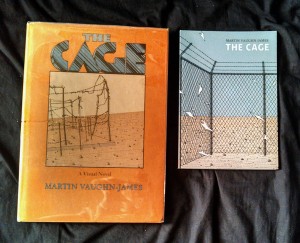 The Cage
The Cage
By Martin Vaughn-James
Coach House Books, November 2013
192 pages / Buy from Coach House Books
In November of this year, Coach House Books released a new edition of their seminal 1975 graphic work, Martin Vaughn-James’s The Cage. When I found this out, I was astounded. I’d been singing the praises of The Cage for years, recognizing it not only as one of the most important (and accomplished) work of graphic fiction ever created, but also insisting upon it being one of the greatest books every produced. Upon its initial publication, there were only 1500 printed copies; beautiful over-sized hardbacks with heavy brown paper inside. The book is a monolith, an object. Just the visual presence matches the title: The Cage, the book, the volume, holds something inside, much as a cage does.
I discovered the book from Richard Kostelanetz’s Dictionary of The Avant-Gardes, a resource that I read from cover to cover, taking note, over the course of the several months I spent reading it, on everything I wanted to learn more about, to discover. And then I spent several months following up on everything I had noted, often not remembering anything about why I had noted a book title or an artist’s name down. I worked in a library at the time, so I would just request anything from Inter-Library-Loan that we didn’t have on our shelves. It was through this process that Martin Vaughn-James’s book came into my life.
I took it home from work and blew through it, realizing that it was doing something heavy, something that I had long wanted the comic form to do, to work with narratives in ways similar to, say, Alain Robbe-Grillet or concrete poets had done, but to make use both of words & images, sequencing and panel development: to open up the tools available to a visual artist who also has a poetic bent. The book accomplishes so much, and I soon became obsessed. I read the book several times while I had it, and then checked it out several more times throughout the year. I desperately wanted to photocopy it (as copies available online were far too expensive) so I could always have it with me, but the book was too big to reasonably photocopy into a facsimile-ish form. I tacked down the three other primarily graphic works from Vaughn-James, again through inter-library loan, and marveled at their contents, but knew that The Cage was his masterpiece. Eventually a copy popped up on the internet for a prize I could sort of afford, so I jumped at it and the book joined my possessions.
To publish this book again in 2013 strikes me as no inconsiderable feat–while comics have certainly gained a larger presence as a “true literary form” (or whatever) by now, most of the dreck that people applaud is, of course, parallel to the novel, “realistic,” though told with pictures in addition to dialog. The Cage takes the height of the 70’s delirious experimentation with form and content, and pushes it into something that, even now, speaks as something new.
As such, I’m pleased to now revisit the work, in two parts. First I will comment upon the initial 1975 release, that is virtually impossible to come by outside of the library at this point, and second, I will consider the reprint, which offers both new front-matter & back-matter, as well as a formally different content, comparing and contrasting the two.
A Note: All photos included in this post were taken on my cellphone and do not necessarily reflect either the colors or the image quality of the printed books themselves
December 17th, 2013 / 12:26 pm
Getting Paid to Play in Paradise: Suehiro Maruo’s STRANGE TALE OF PANORAMA ISLAND
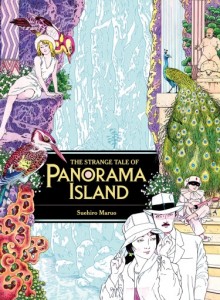 THE STRANGE TALE OF PANORAMA ISLAND
THE STRANGE TALE OF PANORAMA ISLAND
by Suehiro Maruo
Last Gasp, 2013
274 Pages / $24.95 Buy from Last Gasp
I first encountered Suehiro Maruo via the hyper-violent/erotic, aka “ero-guro” collection that Creation Books put out in 2001, ULTRA-GASH INFERNO. It’s a slim volume of short manga narratives, all focused on some sort of extremity. Despite the subject matter, Maruo carried a sense of poetry through the excess, and the resulting combination brought about similar feelings to that which I had first experienced reading the fiction that set me down my life’s trajectory, fiction such as Bataille’s Story of the Eye or Bernard Noel’s Castle of Communion. I became a dedicated fan.
Next encounter–the only other book of Maruo’s available in translation at the time–was Mr. Arashi’s Amazing Freak Show. A more developed narrative (developed in the sense that it is a book-length narrative, instead of only giving itself a few pages to breathe). It rooted itself in the earlier parts of the 20th century, which allows a certain suspension of disbelief necessary to the development of the plotting (which eventually goes off the deep end regardless).
Now, a number of years later–and after a significant waiting period between the announcement of publication and the actual publication of the book (which, I should note, should not be considered a fault)–Maruo’s most developed single-volume narrative yet has become available in English– The Strange Tale of Panorama island.
READ MORE >
July 31st, 2013 / 12:28 pm
The Passion of Gengoroh Tagame
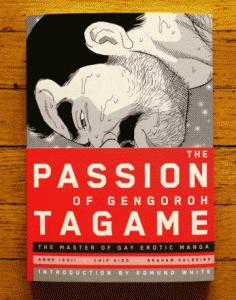 The Passion of Gengoroh Tagame
The Passion of Gengoroh Tagame
by Gengoroh Tagame, ed. Anne Ishii, Chip Kidd & Graham Kobleins
PictureBox Inc, April 2013
256 pages / $29.95 Buy from PictureBox
Passion is generally defined either as “any powerful or compelling emotion or feeling” or, within the context of personal relationships, as a “strong sexual desire; lust.” Strength & power are two words that dominate these definitions. Strength & power are two concepts that dominate the short, hypersexualized narratives of Gengoroh Tagame’s characters: strong, large & butch men dominating, fucking, & occasionally loving other strong, large & butch men.
In the world of manga, and especially in the imported consideration of such, there’s an abundance of yaoi stories that teen girls flock to, love, write fan-fic about: yaoi is a subgenre of manga that takes young, thin, often effeminate boys loving other young, thin, often effeminate boys. Clearly, there’s a contrast between this & what I’ve mentioned Tagame’s narratives hold above: thick muscles, thick cocks, heavy BDSM overtones–there is the occasional cross-generation ‘romance’ told by Tagame, but even the young boy shares a closer physic to a professional wrestler than the twinky waifs that populate yaoi.
Pierre Guyotat once remarked that he couldn’t write unless his cock was hard. Similarly, Tom of Finland once remarked that his best drawings occur while he’s erect. I have to imagine that the sexual narratives that overtake Tagame’s work drive their creator, as well, to sexual satisfaction. There’s a remarkable sense of erotic obsession that drives the work, moving from gang-bang fantasies to hyper-developed arenas of sadism. Sometimes, when there’s time for it to develop, a work develops a plot, often a somewhat complicated one considering the constraint of a number of pages. Sometimes there is less plot, but always there is a surge of powerful eroticism dominating each panel.
READ MORE >
July 5th, 2013 / 2:44 pm
ARE YOU FROM HEAVEN WHAT ARE YOU DOING IN A CITY: CF’s MERE
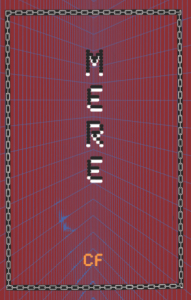 MERE by CF
MERE by CF
PictureBox Inc., 2013
180 Pages / $19.95 Buy From PictureBox
The latest CF volume from PictureBox, MERE offers a collection of 9 zines & a handful of Twitter comics that CF drew & produced throughout 2012. While it’s not as masterful as either CF’s story in Kramer’s Ergot 8, nor is it as complex and beautiful as the on-going POWR MASTRS series, it’s a welcome diversion and a nice stepping stone on the path of CF’s career.
There’s a distinct symbiosis in CF’s zines of both genre aesthetics found in euro-comix of the 70s & 80s along with a messiness that’s present in art brut & a casual culture of creation without perfection–this combination amounts to something very interesting. While there are, ostensibly, ‘narratives’ hidden throughout the volume, they refuse to develop in an articulated, followable fashion. Rather, CF insists upon simply presenting elements of a narrative, frames that seem like they’re out of order or missing important transitions, in order to present a structured chaos. Each zine seems to grow out of the former without any connecting thread.
The volume is organized not chronological, but rather in a fashion that gives a flow to the disjunctive zines. Printed monochromatically on beautiful pale paper, the volume has a great object-hood to it, a book art object even. A design object to be admired. But, luckily, for those who actually like to read books instead of just admiring their design, the content is at times hilarious, at times confusing, and always fascinating.
Nicole Rudick’s introduction to the volume paints a picture that leads to Benjamin’s ideas of the technological reproducability of art. It’s true, in a sense, that the zines the volume holds can and (arguably) should be reproduced over and over again, the machinic-entropy pushing further and further into the Rorschach like blur of toner onto a page, but ultimately there’s a heart to CF’s work that absolves any instability due to an often considered ‘out-moded’ form of technology, the photocopier.
While there’s not as much of an objective coherency in the volume as there was in the stand-alone zine, CITY-HUNTER, much of what I noted of CITY-HUNTER can be applied to the zines found within. The character of Main Dice, introduced in CITY-HUNTER, pops up again and again in various genre permutations, often pitted against a figured named Ven, sometimes to be killed, other times to be changed, but always to be dynamic. In addition to the brief (a-)narrative comic fragments, the volume is also filled with drawings, studies, sketches, all offered in CF’s simultaneously shaky & controlled hand.
A true joy to read and experience, to dip in and out of at will, CF’s MERE offers insight into the working praxis of one of the most interesting comic artists making work today.
June 21st, 2013 / 5:25 pm
Hans Rickheit & the Incurable Souls Lost to the Rest of Society
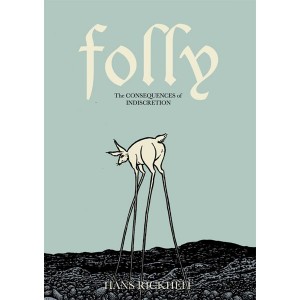 Folly: The CONSEQUENCES of INDISCRETION
Folly: The CONSEQUENCES of INDISCRETION
by Hans Rickheit
Fantagraphic Books, April 2012
144 / $18.99 Buy from Fantagraphics
“The common exclusion of the worst (folly, vice, indolence . . .) seems to me to denote servility. The servile intelligence serves folly, but folly is sovereign: I can change nothing with it.”
—Georges Bataille, Method of Meditation
The folly is my favorite architectural conceit. A building divorced from any sort of purpose, often considered mere decoration; there are architects that have turned the idea of the folly into a sort of space of affect. It seems that the folly gave way to paper architecture, to a developed insistence upon the way space can make someone feel, whether or not the space is constructed out of any sort of desire for utility.
Hans Rickheit’s book, Folly, also serves no utility. Most of the miniature narratives (if you could call them as such), find voided figures wandered through bizarre architectural constructions that seem somewhere between abandoned factory and mad-scientist laboratory, infinite labyrinthine hallways that lead to abject bio-mechanical ‘machines’ that spit out effluvia and viscera. Often, these masses of flesh and organ are alive, they produce sounds, sometimes they serve their own function (often more as that of “sustenance” or offering, battery power), always useless. They are poked and prodded, they squeak and pus.
May 29th, 2012 / 6:37 pm
Two from PictureBox, Inc
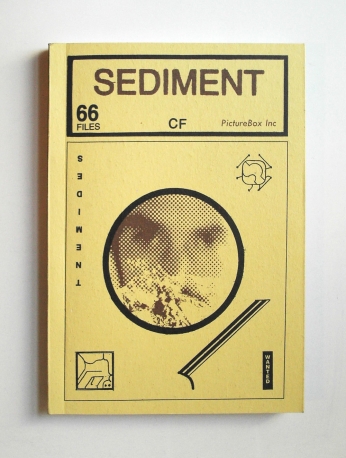 Sediment
Sediment
by CF
PictureBox, 2011
62 Pages / $30 Buy from PictureBox
CF is one of the few people—successfully, in my opinion—working in comics today with a distinct style that is simultaneously distinctly his (though often copied), while also reminiscent of the historical narrative of comics that came before him; recalling specifically Windsor McCay’s work from the beginning of the 20th century, and the multitude of Euro-comics in the 70s and early 80s (think Guido Crepax, Milo Manera or even a primitive Moebius). There’s a hint of what could be considered a naïve sense of character proportion, an acute attention to architectural shapes, and an abject (“melting”) sort of representation.
READ MORE >
April 5th, 2012 / 5:00 pm

